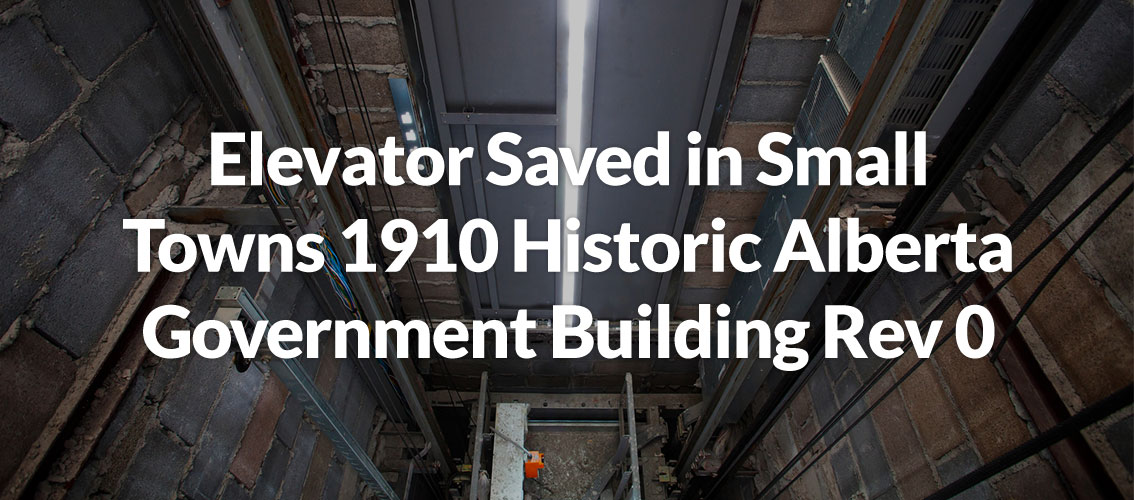FINANCIAL
$
LABOR
$
DECOMMISSIONING
IMPACT
%
- PROJECT SUMMARY
- SITUATION
- Typical Invasive Repairs
- Revive Pipes Solution
- Revives Sewer Replacement Solutions

An Alberta government building was faced with having to close down its antique, manual elevator when a vitrified clay (VCP) sewer drain pipe that was partially embedded in the elevators foundation cracked. The high cost of the sewer pipe repair while keeping the elevator foundation intact was too much for the facility to justify keeping the elevator. Revive Pipes saved the elevator by installing a cured in place pipe (CIPP) structural liner inside of the cracked wastewater sewer pipe. We saved the facility over $100,000, which allowed them to keep their charming, antique elevator.
Staff in the historic building realized there was a problem when they started to smell nasty sewer gases in the area around the antique elevator. Upon further inspection, it was revealed that raw sewage water was leaking from the pipe and collecting in the bottom of the elevator shaft. This was a dangerous situation with potential for Legionella and other types of harmful bacteria and molds to grow. In addition, inspections revealed that some of the pipe that was upstream of the clay pipe in the elevator foundation was extremely deteriorated cast iron sewer pipe that was corroded, cracked and collapsed in places.
The traditional excavate, demolish, replace and repair approach was made much more difficult because of the accessibility of the pipe. Over time, additions to the facility had been built and the area under which the sewer pipes were routed had been closed off in a courtyard that was surrounded on all sides by sections of the building. Excavation was required to access much of the pipe that was buried ten (10) feet below the ground, however no excavation equipment could drive into the courtyard as it had been closed off by the additions to the building.
To perform a traditional sewer pipe replacement, a very costly and invasive repair would have involved:
- Hiring a very large crane to lift some excavating equipment over a section of the building into the courtyard or hiring a specialized hydro vacuum excavation service with a long vacuum boom line to reach over a section of the building into the courtyard.
- Excavating ten (10) feet down to the building foundation and sewer drain pipe to be replaced.
- Shoring of the excavation for safety and to prevent the walls of the trench from collapsing.
- Replacement of the cracked, corroded and damaged sewer pipe in the courtyard.
- Backfilling and compacting of the dirt in the trench
- Replacement of shrubs, grass and sidewalk removed for the trench
- Hiring a structural engineer to evaluate the best alternative in removing the drain pipe embedded in the elevators concrete foundation.
- Installation of bracing or additional foundation supports in the elevator shaft
- Saw cutting and jack hammering of the concrete surrounding the vitrified clay (VCP) sewer pipe
- Installation of a new sewer pipe through the elevator shaft to replace the old sewer pipe
- Saw cutting of concrete slab floor for one section of sewer inside of the building
- Jack hammering and removal of the concrete flooring
- Digging out of the cast iron sewer pipe under the slab
- Replace the cracked, corroded and collapsed cast iron wastewater pipe
- Filling back in the dirt and compacting it
- Pouring new concrete
Revive Pipes used 4 different existing access points in the sewer drain system to rehabilitate the existing sewer pipe with our non-invasive Cured in Place Pipe (CIPP) structural lining service. Three (3) access points used were cleanouts in the system and one (1) access point used was a manhole approximately three hundred (300) feet downstream.
We installed two sections of liner in total. One section started in a PVC pipe that connected to the cracked clay pipe that ran through the elevator shaft foundation. This structural liner section restored the strength to the clay sewer pipe and sealed the crack in the pipe, stopping the sewer odour from permeating the air in the facility and preventing raw sewage from accumulating in the bottom of the elevator shaft.
The second Cured in Place Pipe (CIPP) structural liner we installed was through a section of severely deteriorated cast iron drain pipe that connected to PVC pipe on both ends. The corroded cast iron had basically disintegrated at points so there was no top to the pipe and in other points had heavy scale and corrosion buildup, cracks and small holes. Revive Pipes was able to install a new Cured in Place Pipe (CIPP) inside of the old pipe, sealing the system to prevent sewer gas odours from wafting through the facility and keep sewage from flowing underneath the concrete slab through the cracks and holes in the cast iron wastewater pipe.
Revive Pipes specializes in relining complex sewer pipe configurations inside of buildings with our non-invasive Cured in Place Pipe service. We can line cast iron, clay, PVC, ABS, asbestos concrete, No-Corrode or any other type of sewer drain pipe.
